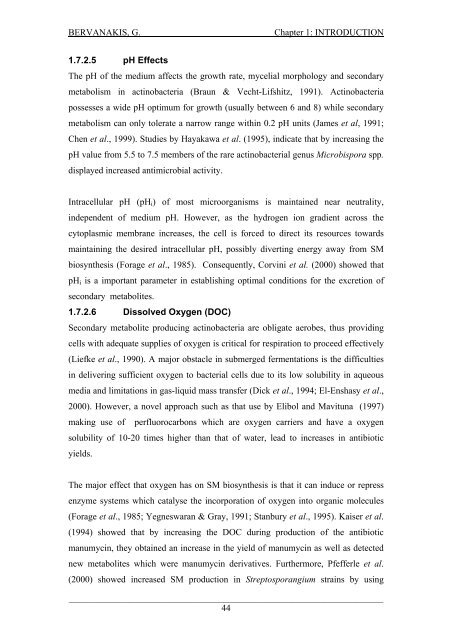Detection and Expression of Biosynthetic Genes in Actinobacteria ...
Detection and Expression of Biosynthetic Genes in Actinobacteria ...
Detection and Expression of Biosynthetic Genes in Actinobacteria ...
Create successful ePaper yourself
Turn your PDF publications into a flip-book with our unique Google optimized e-Paper software.
BERVANAKIS, G.Chapter 1: INTRODUCTION1.7.2.5 pH EffectsThe pH <strong>of</strong> the medium affects the growth rate, mycelial morphology <strong>and</strong> secondarymetabolism <strong>in</strong> act<strong>in</strong>obacteria (Braun & Vecht-Lifshitz, 1991). Act<strong>in</strong>obacteriapossesses a wide pH optimum for growth (usually between 6 <strong>and</strong> 8) while secondarymetabolism can only tolerate a narrow range with<strong>in</strong> 0.2 pH units (James et al, 1991;Chen et al., 1999). Studies by Hayakawa et al. (1995), <strong>in</strong>dicate that by <strong>in</strong>creas<strong>in</strong>g thepH value from 5.5 to 7.5 members <strong>of</strong> the rare act<strong>in</strong>obacterial genus Microbispora spp.displayed <strong>in</strong>creased antimicrobial activity.Intracellular pH (pH i ) <strong>of</strong> most microorganisms is ma<strong>in</strong>ta<strong>in</strong>ed near neutrality,<strong>in</strong>dependent <strong>of</strong> medium pH. However, as the hydrogen ion gradient across thecytoplasmic membrane <strong>in</strong>creases, the cell is forced to direct its resources towardsma<strong>in</strong>ta<strong>in</strong><strong>in</strong>g the desired <strong>in</strong>tracellular pH, possibly divert<strong>in</strong>g energy away from SMbiosynthesis (Forage et al., 1985). Consequently, Corv<strong>in</strong>i et al. (2000) showed thatpH i is a important parameter <strong>in</strong> establish<strong>in</strong>g optimal conditions for the excretion <strong>of</strong>secondary metabolites.1.7.2.6 Dissolved Oxygen (DOC)Secondary metabolite produc<strong>in</strong>g act<strong>in</strong>obacteria are obligate aerobes, thus provid<strong>in</strong>gcells with adequate supplies <strong>of</strong> oxygen is critical for respiration to proceed effectively(Liefke et al., 1990). A major obstacle <strong>in</strong> submerged fermentations is the difficulties<strong>in</strong> deliver<strong>in</strong>g sufficient oxygen to bacterial cells due to its low solubility <strong>in</strong> aqueousmedia <strong>and</strong> limitations <strong>in</strong> gas-liquid mass transfer (Dick et al., 1994; El-Enshasy et al.,2000). However, a novel approach such as that use by Elibol <strong>and</strong> Mavituna (1997)mak<strong>in</strong>g use <strong>of</strong> perfluorocarbons which are oxygen carriers <strong>and</strong> have a oxygensolubility <strong>of</strong> 10-20 times higher than that <strong>of</strong> water, lead to <strong>in</strong>creases <strong>in</strong> antibioticyields.The major effect that oxygen has on SM biosynthesis is that it can <strong>in</strong>duce or repressenzyme systems which catalyse the <strong>in</strong>corporation <strong>of</strong> oxygen <strong>in</strong>to organic molecules(Forage et al., 1985; Yegneswaran & Gray, 1991; Stanbury et al., 1995). Kaiser et al.(1994) showed that by <strong>in</strong>creas<strong>in</strong>g the DOC dur<strong>in</strong>g production <strong>of</strong> the antibioticmanumyc<strong>in</strong>, they obta<strong>in</strong>ed an <strong>in</strong>crease <strong>in</strong> the yield <strong>of</strong> manumyc<strong>in</strong> as well as detectednew metabolites which were manumyc<strong>in</strong> derivatives. Furthermore, Pfefferle et al.(2000) showed <strong>in</strong>creased SM production <strong>in</strong> Streptosporangium stra<strong>in</strong>s by us<strong>in</strong>g_____________________________________________________________________44















